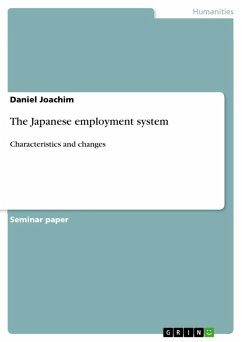Seminar paper from the year 2006 in the subject Sociology - Work, Education, Organisation, grade: 1,7, University of Osnabrück, course: Economical and Technical Development and Organisation, WS 05/06, language: English, abstract: After Japan recovered from the disastrous defeat of World War II, its enormous economic growth provided a series of questions to the world's leading economists. With constant growth rates over 11% on average in the 1960s, Japan had the world's second largest GDP. Seeking explanations and reasons for this phenomenon, soon a couple of important influences on the Japanese economy were found. The increased demands on Japanese products during the conflicts in Vietnam after the Second World War (which led to the Vietnam War 1964-1973) and the Korean War 1950 to 1953 as well as the government aid for selected industries and protective duty accelerated its growth, which exceeded all former expectations1. Another important element of the Japanese prosperity was met with the Japanese-style employment system2. What would primarily influence the image of the Japanese to the further decades, the industrious, never sleeping blue-collar and white-collar workers, fulfilling a life for the company in a state of mutual dependence, is the result of an elaborate employment system. And in fact, lifetime employment, a predetermined career path and the seniority-based wage system were established to commit the regular workers to "their" company, while the temporary workers still did not reach a similar status. This "Japanese Model", as several authors call it, is subject to constant change. Even though the system was never fixed, it changed its surface not before the "collapse of the bubble" in 1990. Shortly after this prolonged economic recession, which forced every industrialised country to undertake economic restructuring, Japan was able to recover very fast through strict rationalisation and a revision of its employment system. Today, Japan has changed. Still the second largest economy of the world, it has to confront an economic growth close to 2%. With this comes a call for a more flexible employment system which still has to pay the regular workers who many years ago were attracted with the seniority-based wage system reflecting the workers higher needs in subsequent years. Furthermore, the new generation of workers is organised in unions and knows their value to the market, and would not agree earning half the sum a senescent worker does.
Dieser Download kann aus rechtlichen Gründen nur mit Rechnungsadresse in A, B, BG, CY, CZ, D, DK, EW, E, FIN, F, GR, HR, H, IRL, I, LT, L, LR, M, NL, PL, P, R, S, SLO, SK ausgeliefert werden.









